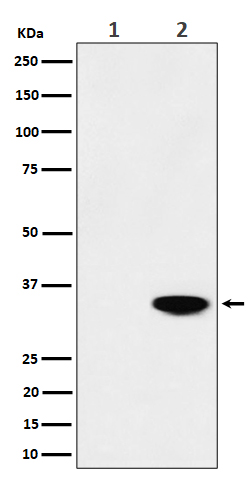产品名称
Phospho-Nucleophosmin (T199) (8B5) Rabbit Monoclonal Antibody
别名
NO38; NPM; NPM1; Nucleolar phosphoprotein B23; Nucleophosmin; nucleophosmin nucleoplasmin family member 1; Numatrin;
纯度
Affinity-chromatography
存储缓冲液
Supplied in 50mM Tris-Glycine(pH 7.4), 0.15M NaCl, 40%Glycerol, 0.01% New type preservative N and 0.05% BSA.
Human Swissprot No.
P06748
免疫原
A synthetic phosphopeptide corresponding to residues surrounding Thr199 of human Nucleophosmin
稀释度
WB: 1:2000 IHC: 1:50 ICC/IF: 1:50 FC: 1:20 IP: 1:20
注意事项
Phospho-Nucleophosmin (T199) Antibody is for research use only and not for use in diagnostic or therapeutic procedures.
细胞定位
Nucleus, nucleolus. Nucleus, nucleoplasm. Cytoplasm, cytoskeleton, microtubule organizing center, centrosome Note=Generally nucleolar, but is translocated to the nucleoplasm in case of serum starvation or treatment with anticancer drugs. Has been found in the cytoplasm in patients with primary acute myelogenous leukemia (AML), but not with secondary AML. Can shuttle between cytoplasm and nucleus. Co- localizes with the methylated form of RPS10 in the granular component (GC) region of the nucleolus. Colocalized with nucleolin and APEX1 in nucleoli. Isoform 1 of NEK2 is required for its localization to the centrosome during mitosis
功能
Involved in diverse cellular processes such as ribosome biogenesis, centrosome duplication, protein chaperoning, histone assembly, cell proliferation, and regulation of tumor suppressors p53/TP53 and ARF. Binds ribosome presumably to drive ribosome nuclear export. Associated with nucleolar ribonucleoprotein structures and bind single-stranded nucleic acids. Acts as a chaperonin for the core histones H3, H2B and H4. Stimulates APEX1 endonuclease activity on apurinic/apyrimidinic (AP) double-stranded DNA but inhibits APEX1 endonuclease activity on AP single-stranded RNA. May exert a control of APEX1 endonuclease activity within nucleoli devoted to repair AP on rDNA and the removal of oxidized rRNA molecules. In concert with BRCA2, regulates centrosome duplication. Regulates centriole duplication: phosphorylation by PLK2 is able to trigger centriole replication. Negatively regulates the activation of EIF2AK2/PKR and suppresses apoptosis through inhibition of EIF2AK2/PKR autophosphorylation. Antagonizes the inhibitory effect of ATF5 on cell proliferation and relieves ATF5-induced G2/M blockade (PubMed:
22528486). In complex with MYC enhances the transcription of MYC target genes (PubMed:
25956029).

